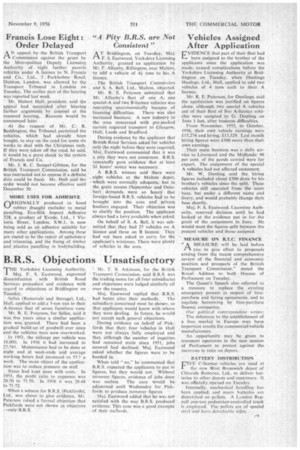B.R.S. Objections Unsatisfactory
Page 47

If you've noticed an error in this article please click here to report it so we can fix it.
THE Yorkshire Licensing Authority, Maj. F. S. Eastwood, expressed dissatisfaction with British Road Services procedure• and evidence with regard to objections at Bridlington on Tuesday.
Selfes (Removals and Storage), Ltd., Hull, applied to add a 3-ton van to their A-licence fleet of seven furniture vans.
Mr. R. E. Paterson, for Selles, said it was five years since a similar application was. granted. There had been a gradual build-up of goodwill ever since and the vehicles were now overworked_
In 1951, the mileage per vehicle was 18.000. In 1956 it had increased to 22.541. Maintenance had to be done at night and at week-ends and average working hours had increased to 55.7 a week. The main object of the application was to reduce pressure on staff.
Rates had kept pace with costs. • In 1951. the profit ratio to expenses was 28.50 to 71.50. In 1956 it was 28.48 to 71.52.
When a witness for B.R.S. (Piekfords), Ltd., was about to give evidence, Mr. Paterson raised a formal objection that Pickfords were not shown as objectors —only B.R.S.
• Mr. T. 13. Atkinson, for the British Transport Commission, said B.R.S. was the trading name for all four subsidiaries and objections were lodged similarly all over the tountry.
Maj. Eastwood replied that B.R.S.
had better alter their methods. The subsidiary concerned must be shown. so that applicants would know with whom they were dealing. In future, he would not accept such general objections.
During evidence on behalf of Pickfords that their, four vehicles in Hull were not always fully employed and that, although the number of inquiries. had remained static since 1951, jobs secured had declined, Maj. Eastwood asked whether the figures were to be handed in.
When told " no," he commented that I3.R.S, expected the applicants to put in figures, but they would not. Without turnover figures. evidence of jobs done was useless. The case would beadjourned until Wednesday for Pickfords to produce .turnover figures.
Maj. Eastwood added that he was not satisfied with the way B.R.S. produced evidence. This case was a good example of their methods.




























































































































